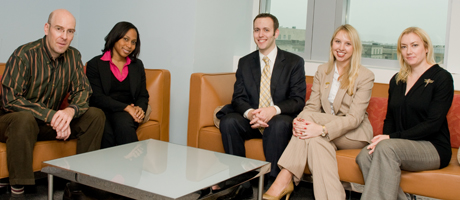With the Army now ranking as Facebook’s largest community and with myriad official and unofficial military blogs and twitter handles, the U.S. armed forces have become pioneers in the use of social media. In a Nov. 12 panel at GW, experts from the military discussed their experiences utilizing social media, including in the immediate aftermath of the recent Fort Hood shootings.
Titled Trust and Authenticity in Social Media: The Case of the U.S. Military, the event also launched the Association for Social Media and Higher Education. A partnership of the Elliott School of International Affairs; the Graduate School of Political Management; the Institute for Politics, Democracy and the Internet; and George Washington Today, the association aims to create a community for information sharing and crafting best practices for the use of social media in higher education.
The panel was introduced by Lorraine Voles, vice president for external relations, and Julie Germany, director of marketing and communications at IPDI, and moderated by Scott Talan, director of communications for the National Association of Schools of Public Affairs and Administration and adjunct faculty member at GW.
In his opening comments, Mr. Talan addressed the seemingly contradictory image of the military as conservative with its pioneering use of social media. “You take an organization like the U.S. military that can be described as serious, insular, secretive, and yet they are one of the leaders when it comes to social media, which is the opposite of all of those things,” said Mr. Talan.
Mr. Talan introduced the panelists: Lindy Kyzer, B.A. ’06, public affairs specialist at the U.S. Army; Steve Field, former spokesman for the Pentagon; and Nicole Schwegman, a junior at GW and former Navy public affairs officer.
The panelists agreed that new media can put pressure on communicators to get the word out quickly -- sometimes too quickly. “It’s changed some of the carefulness,” said Ms. Schwegman, a Naval Academy graduate, who has served in the Navy since 2002. “It’s good to have it out there quickly, but once bad information is gone, there’s no getting it back.”
Ms. Kyzer said, “Definitely, we have a different news business than we used to. There are fewer reporters, and they almost have to rely on social media to get their news.” She said that social media, especially blogs, have made significant gains in credibility both with reporters and with the public.
“There’s an expectation to be immediate, but at the same time you need to get the facts right,” said Mr. Field.
It’s a balancing act that was in evidence after the deadly shootings at Fort Hood. Ms. Kyzer said the Army refrained from communicating via Twitter or other social media until the facts became clear about two or three hours after the incident. “There was a lot of disinformation earlier,” she said.
“We have policies and procedures and a chain of command--we can’t just tweet something we saw on CNN,” said Ms. Kyzer. “It gives us more credibility, because we wait until we know what has actually happened.”
“Twitter is a great tool, but it’s only a tool,” said Ms. Schwegman. “When a crisis situation starts, there is value in taking time to have the facts and questions right.”
Mr. Field said he recognized the perils of communicating before the facts are clear, but asked if the Army could strike a middle ground by “sending something out saying we know there’s a situation and we’re waiting to get the facts.”
“I think that type of communication breeds confidence in your audience,” he added.
Held in 1957 E Street’s Lindner Commons, the panel drew a full house, resulted in more than 150 live tweets, and more than 1,550 clicks on its video feed, which showed up on the homepage of the streaming service Ustream.
“The military community has always adopted new technology early. The Army was one of the first organizations to seriously use online gaming as a tool for recruitment and training,” says Ms. Germany. “Deployed service members have been using online communities and multimedia tools to communicate with their friends and family for years. It makes sense that the military community would use social media in ways that corporate entities, governments and sometimes universities have yet to adopt.”
The Association of Social Media in Higher Education was co-founded by Ms. Germany, Chris Brooks, a presidential administrative fellow in the Leadership Annual Giving division of Development, Grant Schneider, assistant to Elliott School Associate Dean Doug Shaw and Menachem Wecker, editor and writer for George Washington Today.


